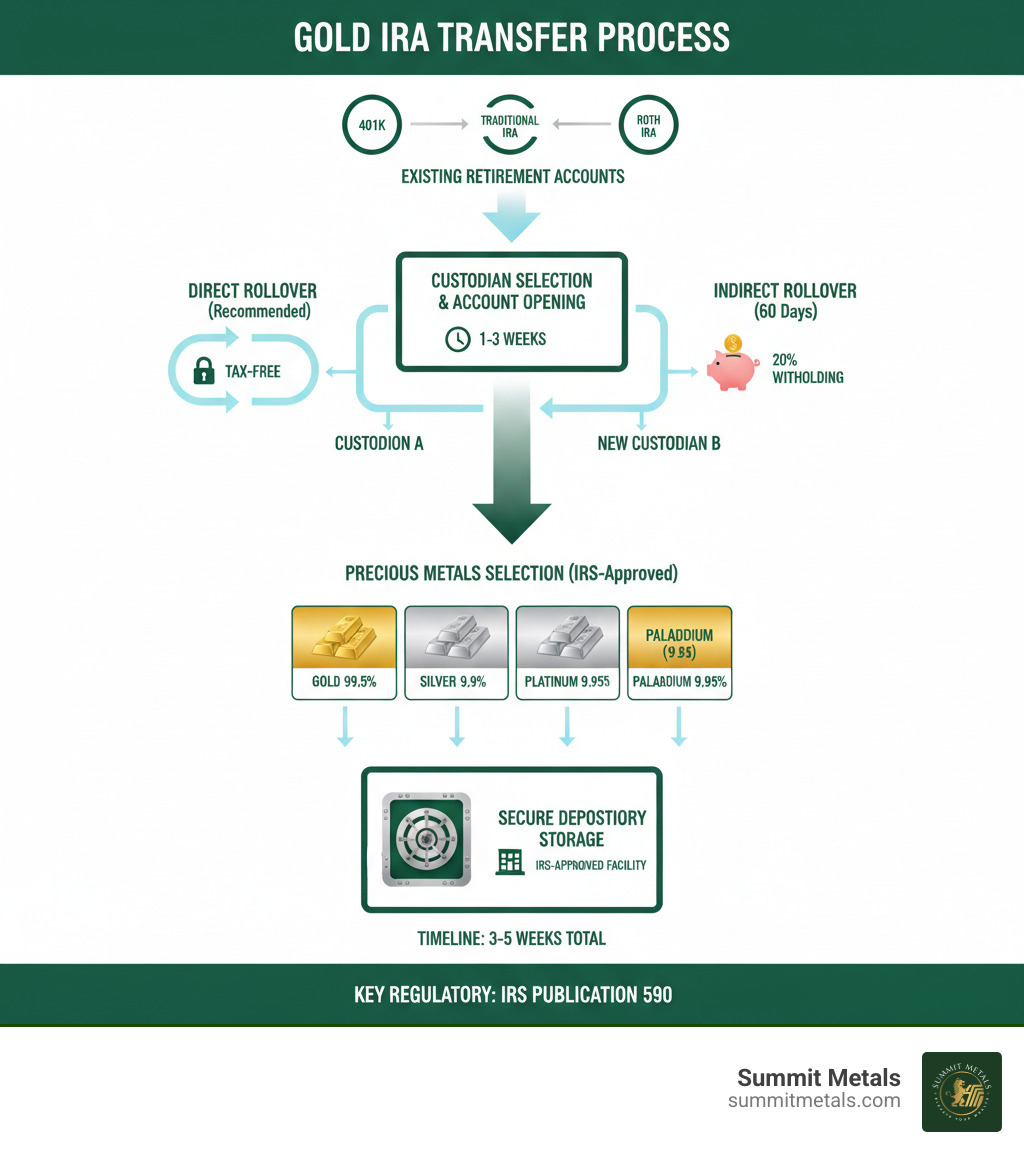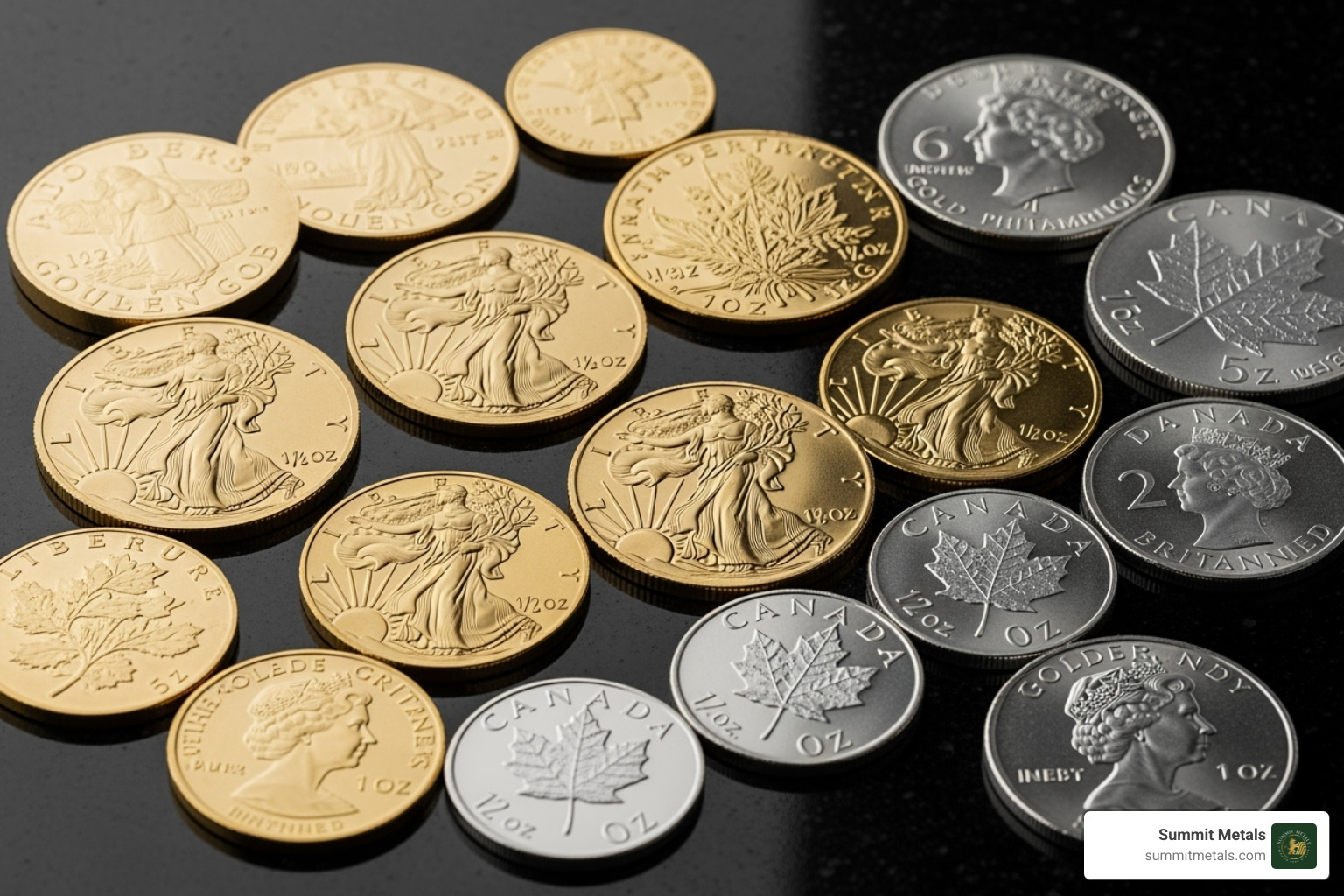Why Gold IRA Transfers Are Gaining Momentum in Today's Economic Climate
A transfer gold ira allows you to move retirement funds from existing accounts (401k, Traditional IRA, Roth IRA) into a self-directed IRA that holds physical precious metals. With inflation concerns and market volatility, more investors are looking to gold for stability. During the 2008 financial crisis, gold gained 25% while major stock indices lost over 50%. Since 1971, gold has increased nearly 5,000%, while the US dollar has lost 86% of its purchasing power.
The appeal is simple: physical gold offers tangible wealth with no counterparty risk. Unlike paper assets, precious metals have served as a store of value for thousands of years. However, the IRS has strict rules about eligible metals, approved storage, and transfer procedures. One mistake can trigger taxes and penalties.
I'm Eric Roach, and with over a decade of experience from Wall Street to precious metals advisory, I help investors apply institutional-level risk management to protect their retirement savings through disciplined diversification.
Key Steps for Gold IRA Transfer:
- Choose an IRS-approved custodian and precious metals dealer
- Open a Self-Directed IRA (SDIRA) account
- Transfer funds via direct rollover (recommended)
- Purchase IRS-approved gold, silver, platinum, or palladium
- Store metals in an IRS-approved depository
Transfer Methods:
- Direct Rollover: Custodian-to-custodian transfer (tax-free, no penalties).
- Indirect Rollover: 60-day window to deposit funds (a 20% tax withholding applies).

Understanding the Gold IRA: A Foundation for Your Future
A Gold IRA is a specialized Self-Directed IRA (SDIRA) that puts you in control of your investments. Unlike typical IRAs limited to stocks and bonds, an SDIRA allows you to hold tangible assets like physical gold and silver.
This is possible due to a special exception in the IRS tax code. Normally, precious metals are considered "collectibles" and are not allowed in retirement accounts. However, Congress created an exception for certain high-purity gold, silver, platinum, and palladium products, which is what makes Gold IRAs possible.
This control over investments is a fundamental difference. Instead of owning paper shares in a company, you own physical bars and coins held in a secure vault. This provides a level of security that digital assets can't match, as you own something that has held value for thousands of years, independent of market performance or corporate management.

Types of Gold IRAs: Which Path is Right for You?
Gold IRAs come in several types, each with distinct tax advantages.
- Traditional Gold IRA: You contribute pre-tax dollars, investments grow with tax-deferred growth, and you pay income tax on withdrawals in retirement. This is ideal if you expect to be in a lower tax bracket during retirement.
- Roth Gold IRA: You contribute after-tax dollars, and all qualified withdrawals in retirement are completely tax-free. This is beneficial if you expect to be in a higher tax bracket later in life. Roth IRAs also have no required minimum distributions during your lifetime.
- SEP Gold IRA: Designed for self-employed individuals and small business owners, this option allows for much higher contribution limits, enabling you to shelter more income in precious metals.
The best choice depends on your current and expected future tax situation. For a deeper dive, check out our Tax-Free vs Tax-Deferred Guide.
The Strategic Benefits of a Gold IRA Transfer
Adding gold to your retirement strategy is a defensive move against economic instability.
- Portfolio Diversification: Traditional portfolios are often heavy in stocks and bonds, which can fall together. Gold often moves independently, helping to smooth out portfolio volatility.
- Hedge Against Inflation: Gold has historically maintained its purchasing power as the value of currencies like the dollar declines. During the high-inflation 1970s, gold prices surged from around $35 to over $800 per ounce.
- Protection from Economic Uncertainty: During the 2008 financial crisis, gold gained value while major stock indices lost over 50%. It provides a safe haven when traditional financial systems are under stress.
- Store of Value: Gold has been a reliable store of value for millennia. This wealth preservation is due to its nature as a tangible asset that exists outside of the promises of companies or governments.
Combining these benefits with the tax advantages of an IRA makes a transfer gold ira a powerful tool for financial security.
The Step-by-Step Process to Transfer Gold IRA Funds
The process of a transfer gold ira can be broken down into four manageable steps. Let's walk through the journey to take control of your retirement savings.

Step 1: Choose a Reputable Custodian and Dealer
This is the most critical decision. You need two key partners:
- The Custodian: An IRS-approved financial institution that holds your assets and ensures compliance with all IRS rules. They handle the administration and paperwork for your SDIRA. Look for a custodian with a strong reputation, transparent fees, and experience with precious metals. Well-known custodians include Equity Trust, STRATA Trust, and Kingdom Trust. If you use Entrust, you can Log In to your Entrust account to begin.
- The Precious Metals Dealer: This is who you buy your metals from (like us at Summit Metals). A good dealer offers transparent, real-time pricing, a wide selection of IRA-eligible products, and expert guidance. We leverage our bulk purchasing power to offer competitive rates without high-pressure sales tactics.
Working with independent specialists for each role often provides better pricing and creates natural checks and balances.
Step 2: Open Your Self-Directed IRA (SDIRA)
Next, you'll officially open your SDIRA account with your chosen custodian. The process is simple:
- Complete the application form, providing personal information and selecting your IRA type (Traditional, Roth, or SEP).
- Submit identification documents as you would for any financial account.
Your custodian will then establish your new SDIRA. This account must be fully open before you can transfer any funds into it. The setup usually takes just a few business days.
Step 3: Initiate the Gold IRA Transfer or Rollover
Now it's time to move your money. You have two options, but the direct rollover is highly recommended.
- Direct Rollover (Trustee-to-Trustee Transfer): This is the safest and easiest method. Your funds move directly from your old custodian to your new one without you ever handling the money. It's tax-free, penalty-free, and you can do as many as you want per year.
- Indirect Rollover: Your old plan sends you a check, and you have 60 days to deposit it into the new IRA. This method is risky. If you miss the deadline, the IRS treats the funds as a taxable withdrawal. Furthermore, your old plan is required to withhold 20% for federal taxes, which you must make up out of pocket to roll over the full amount.
| Feature | Direct Rollover | Indirect Rollover |
|---|---|---|
| Process | Funds move directly between custodians | You receive a check to deposit yourself |
| Tax Withholding | None | Mandatory 20% withholding |
| Deadline | None | Strict 60-day deposit deadline |
| Risk | Very low risk of penalties | High risk of taxes and penalties |
| Frequency | Unlimited | Limited to one per 12 months |
The IRS explains the basic rollover rule, but the direct transfer method avoids the potential pitfalls.
Step 4: Purchase and Store Your Precious Metals
With your account funded, you can now buy your metals.
- Select IRS-Approved Metals: Work with your dealer (like Summit Metals) to choose products that meet IRS purity standards.
- Place Your Purchase Order: You instruct your custodian to purchase the metals on your behalf. The custodian sends the funds to the dealer.
- Secure Storage: The dealer ships the metals directly to an IRS-approved depository. You cannot take personal possession of the metals. These high-security facilities are fully insured. For more details, see our guide on IRA Storage.
You can choose between segregated storage (your specific coins/bars are held separately) or allocated storage (you own a specific quantity of metal held with others of the same type). Your custodian will provide regular statements detailing your holdings. Learn more in our Depository Deep Dive.
Navigating IRS Rules and Regulations for Your Gold IRA
Following IRS rules is essential to maintaining the tax advantages of your Gold IRA. The requirements are straightforward once you understand them.

Eligible Precious Metals for Your IRA
The IRS has specific purity standards for metals held in an IRA:
- Gold: Must be 99.5% pure. An exception is the American Gold Eagle coin, which is approved despite being 91.67% gold, due to its U.S. legal tender status.
- Silver: Must be 99.9% pure.
- Platinum and Palladium: Must be 99.95% pure.
Metals must also be produced by an approved refiner or national government mint. Common IRA-approved products include American Eagles, Canadian Maple Leafs, and Austrian Philharmonics. Collectible (numismatic) coins are generally not allowed. A reputable dealer like Summit Metals will only offer IRA-compliant products. For a full list, read our guide on Precious Metals IRA Regulations 101.
Contribution Limits and Distribution Rules
Gold IRAs follow the same rules as standard IRAs.
- Contributions: For 2025, the annual contribution limit is $7,000. If you are age 50 or older, you can make an additional "catch-up" contribution of $1,000, for a total of $8,000. These limits apply across all your IRA accounts combined.
- Withdrawals: You can begin taking penalty-free withdrawals at age 59½. Withdrawals before this age typically incur a 10% penalty in addition to income taxes.
- RMDs: Required Minimum Distributions (RMDs) begin at age 73 for Traditional and SEP Gold IRAs. Roth Gold IRAs do not have RMDs for the original owner.
When taking distributions, you can receive cash from the sale of your metals or take an in-kind distribution, where the physical bars and coins are shipped to you. This is still a taxable event, but it allows you to take direct possession of your assets.
Common Mistakes to Avoid with a transfer gold ira
Avoid these costly errors to keep your IRA compliant:
- Home Storage IRA Scams: Some companies claim you can store IRA metals at home. This is false. The IRS requires third-party depository storage. Storing metals at home disqualifies the IRA, triggering taxes and penalties.
- Choosing Non-Approved Metals: Purchasing metals that don't meet IRS purity standards will also disqualify your IRA.
- Missing the 60-Day Rollover Deadline: If you use an indirect rollover, failing to deposit the funds within 60 days makes the entire amount a taxable distribution.
- Overlooking Fees: Gold IRAs have administrative and storage fees. Always get a full breakdown of costs from your custodian and dealer to understand their impact on your returns.
- Prohibited Transactions: You cannot use your IRA metals for personal benefit, such as using them as collateral for a loan. This will invalidate your IRA.
Maximizing Your Investment: Advanced Strategies and Considerations
Once your transfer gold ira is established, these strategies can help you optimize your investment for long-term success.
Gold Coins vs. Gold Bars: Making the Right Choice
Both coins and bars are excellent options, but they have key differences.
Gold bars generally have lower premiums over the spot price, meaning you get more gold for your dollar. They are efficient for storing large amounts.
Gold coins, while having slightly higher premiums, offer significant advantages. Their status as legal tender provides powerful fraud protection, as counterfeiting a government-minted coin is a far more serious crime than faking a generic bar. The intricate designs also make them harder to fake. Coins are globally recognized, ensuring excellent liquidity, and come in smaller, divisible sizes (e.g., 1/4 oz, 1/10 oz) for more flexibility when taking distributions.
| Feature | Gold Coins | Gold Bars |
|---|---|---|
| Premiums | Higher | Lower |
| Liquidity | Excellent | Good |
| Divisibility | High (multiple fractional sizes) | Low (typically larger units) |
| Fraud Protection | Strong (Legal Tender Status) | Relies on assay certificates |
For most investors, we recommend gold coins due to the added security and flexibility they provide.
Automating Your Investment with "Autoinvest"
Instead of trying to time the market, consider dollar-cost averaging by making consistent monthly purchases. This disciplined strategy involves investing a fixed amount regularly, which allows you to buy more gold when prices are low and less when they are high, smoothing out volatility over time.
Summit Metals' Autoinvest program makes this easy. You can set up automatic monthly purchases, treating your precious metals portfolio just like a 401(k) contribution. This systematic approach to building wealth removes emotion from your investment decisions.
Learn more about our Autopay subscription service and start building your precious metals holdings with discipline and ease.
Understanding the Risks of a transfer gold ira
No investment is without risk. Be aware of these factors when considering a Gold IRA:
- Price Volatility: Gold prices can fluctuate. It should be viewed as a long-term holding, not a short-term trade.
- Storage and Insurance Costs: Annual fees for depository storage and insurance will slightly reduce your net returns.
- Dealer Premiums: You buy metals at a premium above the spot price and sell at a discount below it. This spread is a transaction cost.
- Liquidity: While gold is liquid, converting it to cash in an IRA takes several business days, which is slower than selling a stock.
- No Yield: Physical gold does not pay dividends or interest. Returns come solely from price appreciation.
Frequently Asked Questions about Gold IRA Transfers
Having guided clients from Wyoming to Salt Lake City through the transfer gold ira process, I've answered many questions. Here are the most common ones.
Can I transfer a 401(k) from a current employer into a Gold IRA?
Generally, no, not if you are still working there and are under age 59½. Most 401(k) plans do not allow in-service distributions for current employees. However, many plans permit rollovers once you reach age 59½, even if you're still employed. If you have left the employer, you can almost always roll over the old 401(k). Contact your plan administrator to confirm your specific options.
How long does a Gold IRA transfer take?
The timeline varies, but a direct transfer is typically faster and safer than an indirect rollover. The total time depends on how quickly your current custodian processes the request. While our part at Summit Metals is quick once funds arrive, the full process usually takes 2-4 weeks. Delays are often caused by simple paperwork errors, so double-check all forms to ensure accuracy.
Can I take physical possession of the gold in my IRA?
No, not while the metals are held within the IRA. IRS rules require that all IRA-held precious metals be stored in an IRS-approved depository to maintain the account's tax-advantaged status. This prevents self-dealing and protects the integrity of the retirement account.
However, you can take an in-kind distribution upon retirement or at any time you choose to take a distribution. This means the actual coins or bars are shipped to you. This is a taxable event, and if you are under age 59½, a 10% early withdrawal penalty will likely apply. For more on these rules, see The Ultimate Rulebook for Precious Metals IRA Investors.
Conclusion
A transfer gold ira is a strategic decision to take control of your financial future. By diversifying with precious metals, you can protect your portfolio against inflation, hedge against economic uncertainty, and gain the security of owning a tangible asset.
The benefits are clear: portfolio diversification, inflation hedging, and control over your investments. While IRS rules require careful attention, working with experienced partners makes the process manageable.
At Summit Metals, we are committed to making this process transparent and straightforward. We offer transparent, real-time pricing and competitive rates to ensure you receive maximum value. Whether you're making your first transfer or building your holdings with our Autoinvest program, we are here to help you achieve long-term financial security.
Ready to take the next step? Our IRA Gold Investment: A Comprehensive Guide to Securing Your Future offers deeper insights. Secure your future with the timeless value of real, tangible wealth.



